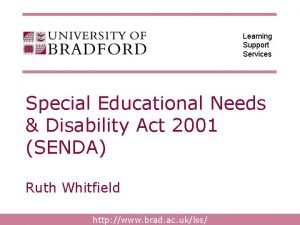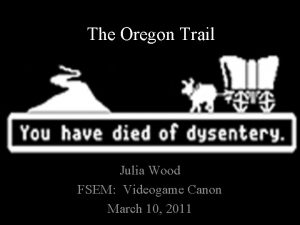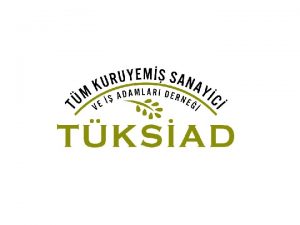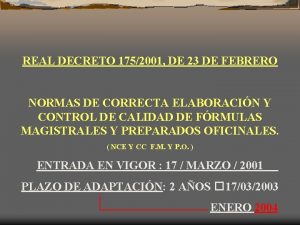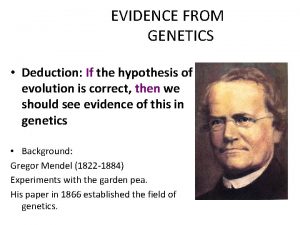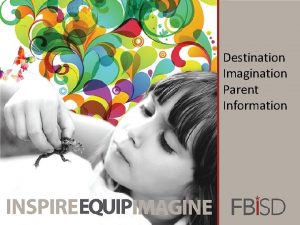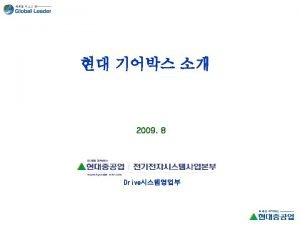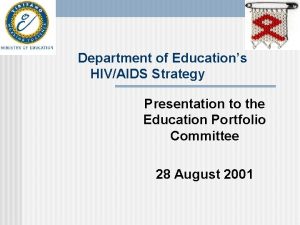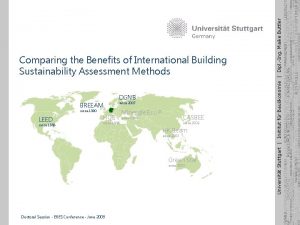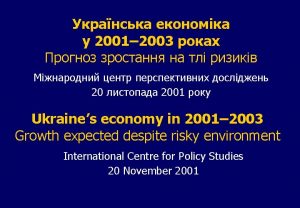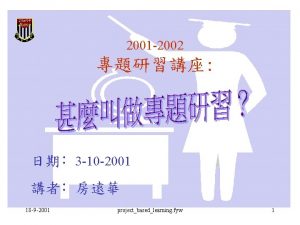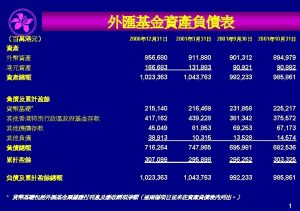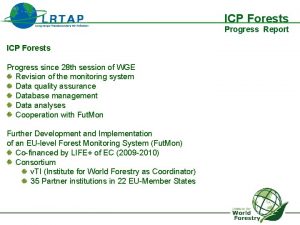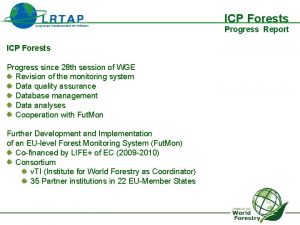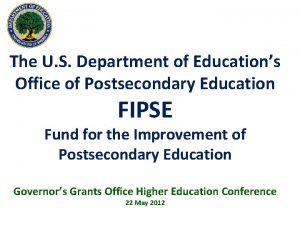Department of Educations HIVAIDS Programme Progress since 2001














- Slides: 14

Department of Education’s HIV/AIDS Programme- Progress since 2001 Presentation to the Education Portfolio Committee 03 September 02 Kgobati Magome, Ministry of Education

Structure of presentation • Context • Priorities for 2001/2002 • Progress on priorities • Lessons learnt and Conclusion

Background • The Government’s five-year strategic plan on HIV and AIDS has as one of its pillars, a recognition that the epidemic is multifaceted and therefore requires a multifaceted, multisectoral response • It lays out a framework within which different sectors should develop strategic responses to HIV/AIDS on the basis of: 1. 2. • how HIV/AIDS affects the mandate of the sector what the sector is best placed to do The Education sector response to HIV/AIDS is located within this broader national multisectoral framework

Do. E’s HIV/AIDS Priorities for 2001/2002 1. Continue the phasing in of the Lifeskills and HIV/AIDS programme into schools with a completion date of 2003 2. Expand the HIV/AIDS response to incorporate both prevention of HIV and mitigation of AIDS 3. Expand the Do. E HIV/AIDS response beyond the General Education Band 4. Mobilise the different sub sectors of education and the many education stakeholders to work in partnership against AIDS

Phasing in of Lifeskills and HIV/AIDS programme • The main objective is to equip learners with knowledge, skills, attitudes and values necessary to adopt healthy sexuality and positive lifestyles. • This is done through integrating life skills and HIV/AIDS content within the Life Orientation Learning Area of C 2005 and across other learning areas of the new curriculum. • The programme is based on OBE principles and is age –appropriate.

Approved Budget Allocations

Phasing in of Lifeskills and HIV/AIDS programme- continued • Key Activities and Progress: - 22, 800 educators from Grades 1 -12 and 683 Master trainers trained - Appropriate learner and educator support materials have been developed and printed for Gr. 1 -12. - Parent resource guides on communicating sexuality issues to their children developed and printed in all official languages - Advocacy and Information Workshops for School Governing Bodies and other stakeholders are being held. - The programme is being phased in over a three-year period on 20%-40% basis. Implementation is on phase 2 and 60% of all schools are expected to be implementing the programme by end of this financial year.

Phasing in of Lifeskills and HIV/AIDS programme- Expenditure • 71. 74% of the total R 87 million transferred to provinces was spent in the 2001/2002 financial year • This was an improvement on the 23. 14% expenditure of 2000/2001. • Improvement a result of the monitoring systems put in place by provincial and national departments

Expand the HIV/AIDS response • A programme focussing on ensuring access to education and other social services for learners, particularly those orphaned • Takalani Sesame - Muppet living with HIV - Main objective is to create dialogue and model behaviour on: age-appropriate HIV and AIDS related knowledge, skills and attitudes for children - - caring and supportive environments for the infected and affected - breaking the cycle of silence and stigma associated with HIV and AIDS - The Minister of Education will launch series, 17 th September. • The development of a life skills programme for teachers- prevention and positive living

Expand the HIV/AIDS response • Communicate the Department’s HIV/AIDS policies on learners and educators and review other policies to ensure that they are responsive to the challenges of HIV and AIDS • HIV/AIDS is been mainstreamed into the core functions of different Do. E units within different branches- as evidenced by the new strategic plan on HIV/AIDS • The Higher Education Against HIV/AIDS programme in collaboration with SAUVCA and CTP

Mobilise the sub sectors and stakeholders of education • Conference on HIV/AIDS and the education sector - A declaration by the different sub-sectors of the education sector and its collaborating partners to join hands in a partnership of hope against HIV/AIDS and its impacts on the nation - The sector acknowledged that it is principally through education that an AIDS – free South Africa can be achieved and therefore agreed to maximize efforts to place education at the heart of the national response to HIV/AIDS • A plan of action for the education sector- enclosed

Mobilise the sub sectors and stakeholders of education • Post-conference activities: - Setting up of a steering committee to manage the education coalition and the implementation of the plan of action - Setting up of sub-sector committees to support and monitor the implementation of the plan of action - Four sub-sector committees are envisaged: GET, FET, Higher Education and management and planning of education.

Key elements of the sector plan • Customs, belief systems and the status of women and girls in the community are fundamental to the success of the life skills and HIV/AIDS programme in schools. • The involvement of traditional and community leaders is therefore critical • Peer-education amongst learners as an essential supplement to the curriculum • Management fundamentals need to be strengthened in order to respond to HIV and AIDS effectively. This includes management capacity, monitoring and evaluation of programmes • Setting up of a unit needs to be backed by a system-wide response with adequate human and financial resources

Conclusion • Education is the greatest “social vaccine” available today • Resources need to be directed to the most critical area of need and intervention: At the school and community level. • Programmes need to impact at the individual level • HIV/AIDS strategies need to incorporate customs, belief systems and the status of women and girls in the community – these are fundamental to the success of the response to HIV/AIDS • Ultimately, the vision is to have schools and institutions that are managed and governed effectively to serve at the forefront of developing a future generation without AIDS • Sept 02 nd to 08 th is school AIDS week, focusing on assuming this role
 Pearson educations
Pearson educations Physical progress and financial progress
Physical progress and financial progress 1979 türkiye güzeli
1979 türkiye güzeli Special educational needs and disability act 2001
Special educational needs and disability act 2001 Amc 8 2005 answer key
Amc 8 2005 answer key Copyright 2001
Copyright 2001 Oregon trail 2001
Oregon trail 2001 2001 fındık fiyatları
2001 fındık fiyatları X xxxxx
X xxxxx Real decreto 175 de 2001
Real decreto 175 de 2001 6022/2001
6022/2001 Gothenburg riots 2001
Gothenburg riots 2001 Destination imagination 2001
Destination imagination 2001 Agma 2001-b88
Agma 2001-b88 2001 course
2001 course



